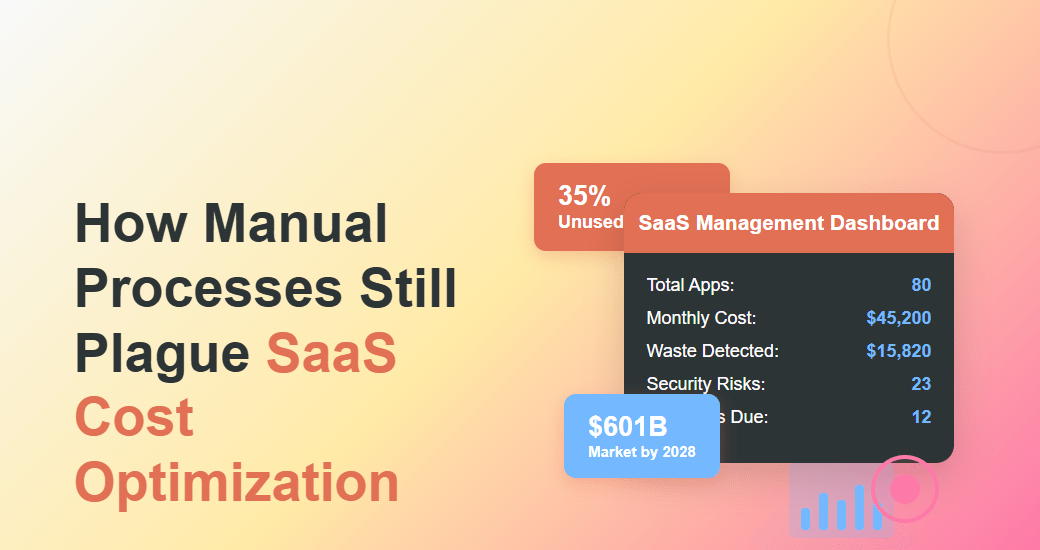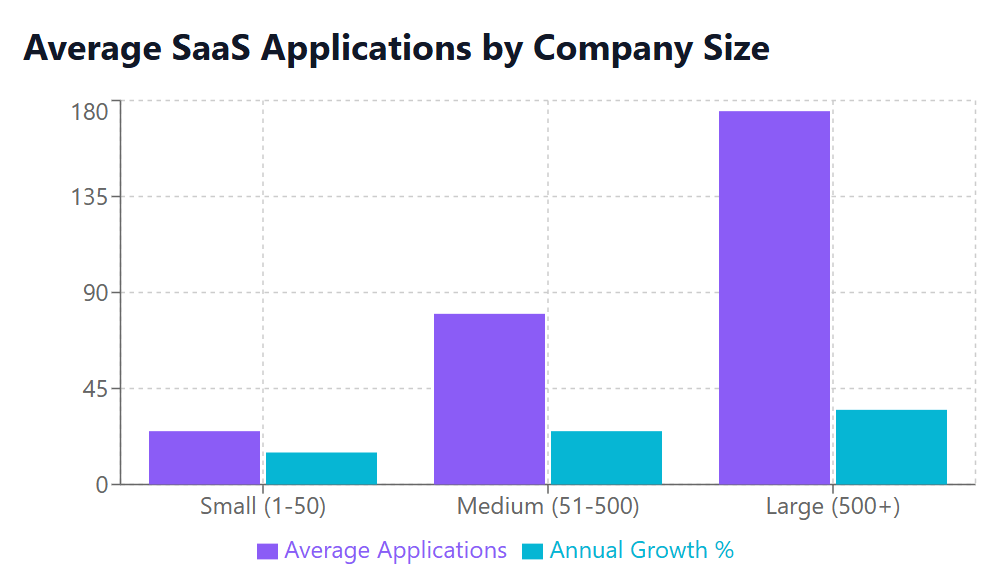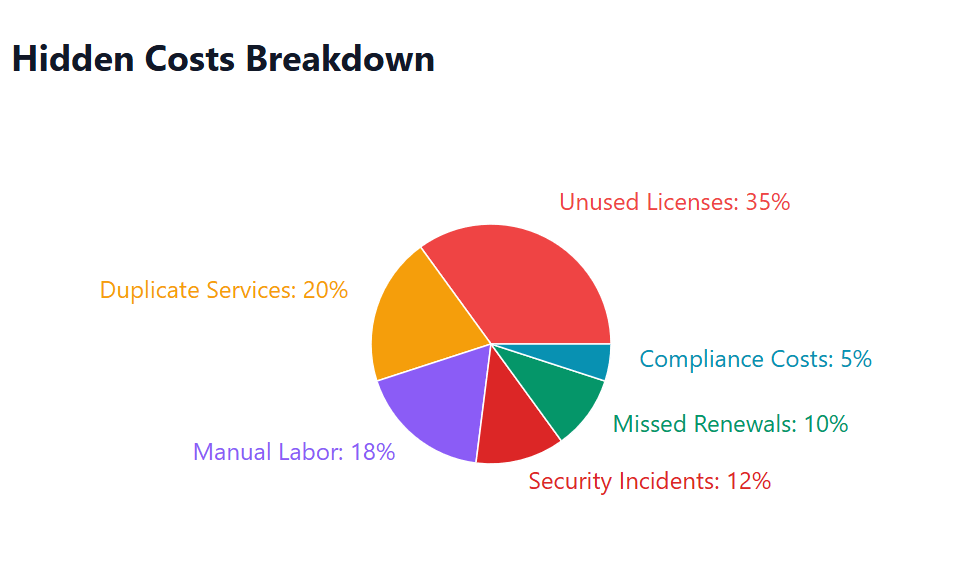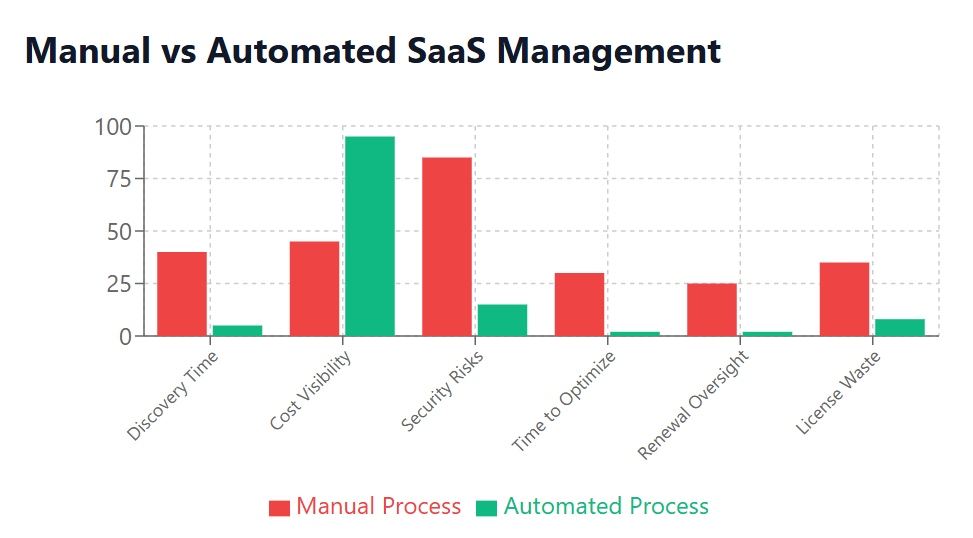
The Current State of SaaS Management
The modern business landscape has witnessed an unprecedented adoption of Software as a Service (SaaS) solutions. Organizations now use an average of 80 applications, with the global SaaS market projected to reach $601 billion by 2028, growing at an annual rate of 26.7%. Despite this massive growth and the sophisticated nature of SaaS products themselves, many organizations still rely heavily on manual processes for SaaS cost optimization and management.
This paradox presents a significant challenge for businesses seeking to maximize their return on investment in cloud computing and SaaS solutions. While SaaS applications offer scalability, accessibility, and automatic updates through their subscription model, the management of these subscriptions often remains trapped in outdated, manual workflows that create inefficiencies, increase costs, and expose organizations to unnecessary risks.
The distribution model of SaaS software through cloud hosting and internet delivery has revolutionized how businesses access and utilize software applications. However, the processes for managing, monitoring, and optimizing these SaaS investments have not evolved at the same pace. Many organizations continue to track SaaS subscriptions through spreadsheets, rely on manual renewal reminders, and make cost optimization decisions based on incomplete or outdated information.
This disconnect between advanced SaaS technology and primitive management processes creates a significant opportunity for improvement. Organizations that recognize and address these manual process limitations can achieve substantial cost savings, improved operational efficiency, and better strategic alignment of their SaaS stack with business objectives.

Why Manual Processes Persist in SaaS Cost Management
Understanding why manual processes continue to dominate SaaS cost management is crucial for organizations looking to modernize their approach. Several factors contribute to this persistence, often creating a perfect storm of inefficiency and missed opportunities.
Legacy Mindset and Organizational Inertia
Many organizations approach SaaS management with the same mindset they used for traditional on-premises software. The subscription model and cloud-based delivery of SaaS solutions require fundamentally different management approaches, but organizational inertia often prevents the adoption of new methodologies. Finance teams, accustomed to handling one-time software purchases, struggle to adapt to the ongoing nature of SaaS subscriptions and the dynamic pricing models that many SaaS vendors employ.
Lack of Centralized Ownership
Unlike traditional software procurement, which typically falls under IT department oversight, SaaS applications are often purchased and managed by individual departments or teams. This decentralized approach makes it difficult to establish automated processes and centralized SaaS governance policies. Each team may develop its own manual tracking methods, leading to inconsistencies and gaps in visibility across the organization.
Underestimation of Complexity
At first glance, managing SaaS subscriptions appears straightforward – pay monthly or annually for access to cloud applications. However, the reality is far more complex. Modern SaaS solutions offer multiple pricing tiers, user-based pricing, feature-specific add-ons, and usage-based billing models. This complexity requires sophisticated SaaS spend management tools and processes that many organizations have not yet implemented.
Rapid Growth and Scaling Challenges
As organizations grow and add more SaaS applications to their stack, manual processes that may have worked for a handful of subscriptions become overwhelmed. The exponential growth in SaaS adoption often outpaces the development of proper management infrastructure, leaving organizations scrambling to maintain visibility and control through increasingly inadequate manual methods.
Budget and Resource Constraints
Implementing automated SaaS management platforms requires upfront investment and dedicated resources. Organizations operating under tight budget constraints may view manual processes as a cost-effective alternative, failing to recognize the hidden costs and missed savings opportunities that result from inefficient SaaS cost management.
The Hidden Costs of Manual SaaS Management
Manual SaaS management processes impose significant hidden costs that extend far beyond the obvious inefficiencies. These costs often remain invisible to leadership because they manifest as opportunity costs, security risks, and operational inefficiencies rather than direct line items in financial reports.

Subscription Sprawl and Duplicate Services
Without automated discovery and monitoring capabilities, organizations frequently accumulate redundant SaaS subscriptions. Different teams may independently subscribe to similar SaaS solutions, creating expensive overlap. Manual tracking methods fail to identify these duplications until they become significant cost centers. A comprehensive SaaS audit often reveals multiple subscriptions serving identical functions, with organizations paying for redundant capabilities that could be consolidated.
Renewal Date Oversight and Automatic Renewals
Manual renewal tracking through spreadsheets or calendar reminders creates opportunities for costly oversights. SaaS vendors typically implement automatic renewal clauses that continue subscriptions unless explicitly canceled. Organizations relying on manual processes often miss renewal dates, resulting in unintended subscription extensions for unused or underutilized services. These automatic renewals can accumulate substantial costs over time, particularly for enterprise-level SaaS solutions with significant annual fees.
Underutilized License Management
Manual user access management leads to significant waste in license utilization. When employees leave the organization or change roles, their SaaS access often remains active due to inadequate manual deprovisioning processes. These abandoned licenses continue generating costs while providing no business value. Similarly, manual processes struggle to identify underutilized licenses where users have access but minimal usage, representing opportunities for rightsizing subscriptions.
Security and Compliance Risks
Manual SaaS management creates substantial security risks that can result in costly data breaches, compliance violations, and regulatory penalties. Without automated user access controls and monitoring, organizations struggle to maintain proper security governance across their SaaS stack. Former employees may retain access to sensitive systems, privileged accounts may go unmonitored, and security policy violations may remain undetected until significant damage occurs.
Time and Resource Allocation Inefficiencies
Manual SaaS management consumes substantial employee time that could be directed toward higher-value activities. Finance teams spend hours reconciling SaaS invoices, IT departments manually track user access across multiple platforms, and procurement teams negotiate contracts without comprehensive usage data. This time investment represents a significant opportunity cost, particularly when considering the salaries of skilled professionals engaged in routine manual tasks.
Missed Optimization Opportunities
Manual processes lack the analytical capabilities to identify cost optimization opportunities effectively. Without automated usage analytics and spend analysis, organizations miss opportunities to negotiate better rates with SaaS vendors, optimize subscription levels, or identify alternatives that provide better value. These missed opportunities compound over time, resulting in substantially higher SaaS costs than necessary.
Common Manual Process Bottlenecks
Several specific bottlenecks consistently emerge in organizations relying on manual SaaS management processes. Understanding these bottlenecks helps identify areas where automation can provide the most significant impact.
Invoice Processing and Reconciliation
Manual invoice processing for SaaS subscriptions creates significant bottlenecks, particularly for organizations with diverse payment methods and multi-currency operations. Finance teams must manually match invoices to approved subscriptions, validate charges against contracted rates, and reconcile payments across multiple corporate cards and bank accounts. This process becomes increasingly complex as organizations scale their SaaS usage across different regions and departments.
The challenge intensifies when SaaS vendors change their billing structures, introduce new features, or adjust pricing models. Manual reconciliation processes struggle to adapt quickly to these changes, leading to delayed payments, disputed charges, and strained vendor relationships. Organizations often discover billing discrepancies months after they occur, making resolution more difficult and expensive.
User Access Provisioning and Deprovisioning
Manual user management across multiple SaaS platforms creates significant operational bottlenecks. IT teams must individually manage user accounts across dozens or hundreds of SaaS applications, each with unique access controls and administrative interfaces. New employee onboarding requires manual account creation across relevant platforms, while employee departures necessitate individual account deactivation across all subscribed services.
This manual approach not only consumes substantial IT resources but also creates security vulnerabilities and compliance risks. Delayed deprovisioning allows former employees to retain access to sensitive systems, while inconsistent provisioning may grant excessive permissions or fail to provide necessary access for new team members.
Renewal Management and Contract Negotiations
Manual renewal management creates bottlenecks that often result in rushed decision-making and suboptimal contract terms. Organizations tracking renewals through spreadsheets or calendar reminders frequently discover upcoming renewals with insufficient time for proper evaluation and negotiation. This time pressure often leads to automatic renewals at existing terms, missing opportunities for better pricing or more favorable contract conditions.
The situation becomes more complex when organizations need to evaluate usage patterns, user feedback, and alternative solutions before renewal decisions. Manual data collection and analysis for these evaluations consume significant time and resources, often resulting in incomplete information and suboptimal decisions.
Usage Monitoring and Optimization
Manual usage monitoring represents one of the most significant bottlenecks in SaaS cost optimization. Organizations attempting to track usage patterns manually across multiple SaaS platforms face an almost impossible task. Each platform provides different analytics interfaces, reporting formats, and data export capabilities, making comprehensive usage analysis extremely time-consuming.
Without automated usage monitoring, organizations cannot identify underutilized licenses, optimize subscription levels, or make data-driven decisions about SaaS investments. This bottleneck prevents effective rightsizing of subscriptions and identification of cost-saving opportunities.
The Impact of Manual Processes on Different Teams
Manual SaaS management processes affect different organizational teams in unique ways, creating cascading inefficiencies throughout the organization.

Finance and Accounting Teams
Finance teams bear a disproportionate burden from manual SaaS management processes. They must manually track subscriptions across multiple payment methods, reconcile charges against approved budgets, and prepare reports on SaaS spending without comprehensive automated tools. The subscription model of SaaS creates ongoing accounting challenges that traditional software purchasing processes never addressed.
Manual invoice processing requires finance teams to validate charges across dozens or hundreds of SaaS vendors, each with different billing cycles, pricing structures, and contract terms. This process becomes exponentially more complex for organizations with multi-country operations and multi-currency payments, requiring currency conversions and regional cost allocations.
IT and Security Teams
IT teams struggle with manual user management across proliferating SaaS platforms. Each new SaaS adoption adds to their administrative burden, requiring learning new interfaces, managing additional user accounts, and maintaining security standards across diverse platforms. Manual processes make it difficult to enforce consistent security policies, monitor user access, and respond quickly to security incidents.
The challenge extends to integration management, where IT teams must manually configure and maintain connections between SaaS applications and existing enterprise systems. Without automated integration tools, these connections often require ongoing manual maintenance and troubleshooting.
Procurement and Vendor Management
Procurement teams face unique challenges when managing SaaS contracts and vendor relationships manually. Unlike traditional software purchases with clear specifications and one-time costs, SaaS procurement requires ongoing evaluation of usage patterns, feature utilization, and cost-effectiveness. Manual processes make it difficult to gather the comprehensive data needed for effective vendor negotiations and contract optimizations.
Department and Team Leaders
Individual department heads and team leaders often become inadvertent SaaS managers when manual processes create governance gaps. They may independently subscribe to SaaS solutions to address immediate business needs, creating shadow IT challenges and duplicating functionality across departments. Manual tracking methods fail to provide visibility into these distributed decisions, leading to organizational inefficiencies.
Shadow IT and Uncontrolled SaaS Adoption
One of the most significant consequences of manual SaaS management processes is the proliferation of shadow IT and uncontrolled SaaS adoption. When formal procurement and management processes are cumbersome and slow, employees and departments often bypass official channels to access needed functionality through direct SaaS subscriptions.
The Ease of SaaS Adoption
The subscription model and internet delivery of SaaS applications make it remarkably easy for employees to subscribe to services independently. Unlike traditional software that required IT involvement for installation and configuration, SaaS solutions can be accessed immediately with a simple online signup process. This ease of adoption, while beneficial for productivity, creates significant challenges for organizations relying on manual management processes.
Lack of Visibility and Control
Manual tracking methods cannot effectively monitor and control distributed SaaS adoption across large organizations. Departments may subscribe to specialized SaaS solutions without informing IT or finance teams, creating visibility gaps that persist until billing statements reveal unexpected charges. By the time these subscriptions are discovered, they may have been active for months, making cost recovery and vendor management more challenging.
Compliance and Security Implications
Uncontrolled SaaS adoption through shadow IT creates substantial compliance and security risks. Organizations may unknowingly process sensitive data through unvetted SaaS platforms that lack appropriate security controls or compliance certifications. Manual processes cannot effectively monitor data flows, assess vendor security practices, or enforce organizational policies across unauthorized SaaS deployments.
Cost Accumulation and Vendor Fragmentation
Shadow IT leads to vendor fragmentation and cost accumulation that manual processes struggle to address. Organizations may end up with relationships with dozens of small SaaS vendors, each requiring individual contract management, security assessment, and payment processing. The administrative overhead of managing these relationships manually often exceeds the cost of the subscriptions themselves.
Manual vs. Automated SaaS Management Comparison
Understanding the stark differences between manual and automated SaaS management approaches highlights the compelling case for automation in SaaS cost optimization.

Discovery and Inventory Management
Manual discovery processes rely on employee reporting, expense account reviews, and periodic surveys to identify SaaS subscriptions. This approach inevitably misses shadow IT deployments and provides incomplete visibility into organizational SaaS usage. Automated discovery tools can scan network traffic, analyze payment records, and integrate with single sign-on systems to provide comprehensive SaaS inventory management.
Automated platforms maintain real-time visibility into all SaaS subscriptions, including those purchased through individual credit cards or departmental budgets. This comprehensive visibility enables better decision-making and cost optimization opportunities that manual processes cannot identify.
Cost Analysis and Optimization
Manual cost analysis requires substantial time investment to gather usage data, analyze spending patterns, and identify optimization opportunities. Finance teams must manually compile reports from multiple sources, often working with outdated or incomplete information. Automated SaaS spend management platforms provide real-time cost analysis, usage analytics, and optimization recommendations based on comprehensive data collection.
Automated tools can identify underutilized licenses, duplicate subscriptions, and rightsizing opportunities that manual processes typically miss. They can also track spending trends, predict future costs, and provide actionable insights for cost reduction initiatives.
User Access Management
Manual user access management requires individual attention to each SaaS platform, making it time-consuming and error-prone. Automated user provisioning and deprovisioning can integrate with human resources systems to automatically manage access across all SaaS applications based on employee status changes.
Automated access management ensures consistent security policies, reduces the risk of unauthorized access, and eliminates the manual effort required to maintain user accounts across dozens or hundreds of SaaS platforms.
Renewal and Contract Management
Manual renewal tracking through spreadsheets and calendar reminders creates opportunities for oversight and suboptimal decision-making. Automated renewal management provides advance notification of upcoming renewals, comprehensive usage analysis for renewal decisions, and integration with procurement processes for contract negotiations.
Automated systems can track contract terms, monitor compliance with negotiated discounts, and provide historical usage data to support renewal negotiations. This information enables organizations to make data-driven decisions about renewals and optimize contract terms based on actual usage patterns.
The Path to Automated SaaS Cost Optimization
Transitioning from manual to automated SaaS cost optimization requires a strategic approach that addresses organizational, technical, and cultural challenges.
Assessment and Planning Phase
Organizations should begin by conducting a comprehensive assessment of their current SaaS landscape and manual management processes. This assessment should identify all existing SaaS subscriptions, document current management workflows, and quantify the costs and inefficiencies of manual processes.
The planning phase should establish clear objectives for automation, including cost reduction targets, security improvements, and operational efficiency gains. Organizations should also identify key stakeholders across finance, IT, procurement, and business units who will be involved in the transition process.
Technology Selection and Implementation
Selecting the right SaaS management platform requires careful evaluation of organizational needs, existing technology infrastructure, and integration requirements. Organizations should prioritize platforms that can integrate with existing financial systems, identity management solutions, and cloud infrastructure.
Implementation should follow a phased approach, beginning with discovery and inventory management before expanding to include cost optimization, user access management, and automated workflows. This phased approach allows organizations to realize immediate benefits while building expertise and confidence in automated processes.
Integration with Existing Systems
Successful automation requires integration with existing organizational systems, including accounting software, human resources information systems, and procurement platforms. These integrations enable automated data flows that eliminate manual data entry and ensure consistency across organizational processes.
Cloud integration capabilities are particularly important for organizations using multiple cloud providers alongside their SaaS applications. Comprehensive cost management requires visibility into both SaaS subscriptions and underlying cloud infrastructure costs.
Process Standardization and Governance
Automation implementation provides an opportunity to standardize SaaS management processes and establish comprehensive governance policies. Organizations should develop clear policies for SaaS procurement, usage monitoring, security requirements, and renewal management.
These governance policies should be embedded in automated workflows to ensure consistent enforcement and reduce the risk of policy violations. Automated approvals, spending limits, and security assessments can help organizations maintain control while enabling business agility.
Best Practices for Transitioning from Manual to Automated
Successfully transitioning from manual to automated SaaS management requires careful attention to organizational change management, technical implementation, and ongoing optimization.
Stakeholder Engagement and Change Management
Successful automation initiatives require buy-in from stakeholders across the organization. Finance teams need to understand how automation will improve their visibility and control over SaaS spending. IT teams need assurance that automated processes will enhance rather than compromise security. Business units need confidence that automation will not impede their access to necessary SaaS tools.
Change management efforts should emphasize the benefits of automation while addressing concerns about process changes and learning new systems. Training programs should be developed to help stakeholders effectively use new automated tools and processes.
Data Quality and Standardization
Automated systems depend on high-quality, standardized data to function effectively. Organizations should invest time in cleaning existing SaaS data, standardizing naming conventions, and establishing data quality processes before implementing automation.
This preparation phase should include reconciling existing SaaS inventories, validating contract terms and pricing information, and establishing standard categories and tags for cost allocation and reporting.
Gradual Implementation and Testing
Rather than attempting to automate all SaaS management processes simultaneously, organizations should implement automation gradually, starting with the most critical or problematic areas. This approach allows for testing and refinement of automated processes before expanding to additional areas.
Pilot programs with specific departments or SaaS categories can help identify potential issues and optimize processes before organization-wide deployment. These pilots also provide opportunities to demonstrate value and build organizational confidence in automated approaches.
Continuous Monitoring and Optimization
Automated SaaS management is not a “set it and forget it” solution. Organizations need to continuously monitor the effectiveness of automated processes, analyze the insights provided by automated tools, and optimize their SaaS usage based on data-driven recommendations.
Regular reviews of automated reports and recommendations should be scheduled to ensure that cost optimization opportunities are identified and acted upon. Organizations should also establish feedback loops to improve automated processes based on user experience and changing business requirements.
Vendor Relationship Management
Automation can actually improve vendor relationship management by providing comprehensive usage data and performance metrics that support more effective negotiations. Organizations should leverage automated insights to build stronger partnerships with key SaaS vendors and optimize contract terms based on actual usage patterns.
Automated renewal management can also help organizations approach vendor negotiations from a position of strength, with comprehensive data about usage patterns, user satisfaction, and alternative options.
Conclusion
The persistence of manual processes in SaaS cost optimization represents one of the most significant missed opportunities in modern business technology management. While organizations have embraced sophisticated SaaS solutions to improve their operational efficiency and scalability, many continue to manage these investments through outdated manual processes that create inefficiencies, increase costs, and expose organizations to unnecessary risks.
The hidden costs of manual SaaS management extend far beyond the obvious inefficiencies. Subscription sprawl, security vulnerabilities, missed optimization opportunities, and resource allocation inefficiencies create substantial financial and operational impacts that often remain invisible to organizational leadership. These costs compound over time, making the total cost of ownership for SaaS solutions significantly higher than necessary.
The path forward requires a strategic commitment to automation that addresses both technical and organizational challenges. Successful organizations recognize that effective SaaS cost optimization requires purpose-built tools and processes designed specifically for the unique characteristics of subscription-based, cloud-delivered software solutions.
Automated SaaS management platforms provide the visibility, control, and optimization capabilities that manual processes cannot deliver. These platforms enable organizations to discover and track all SaaS subscriptions, optimize spending through data-driven insights, automate user access management, and maintain security and compliance standards across their entire SaaS stack.
The transition from manual to automated SaaS management represents more than a technology upgrade – it represents a fundamental shift toward data-driven decision-making and strategic SaaS governance. Organizations that successfully make this transition position themselves to maximize the value of their SaaS investments while minimizing the risks and costs associated with manual management processes.
As the SaaS market continues to grow and evolve, the organizations that thrive will be those that recognize SaaS cost optimization as a strategic capability requiring sophisticated tools and processes that manual processes simply cannot provide. The question is not whether to automate SaaS management, but how quickly organizations can implement automated solutions to capture the substantial benefits and avoid the escalating costs of continued manual processes.
The future of SaaS cost optimization lies in embracing automation, data-driven insights, and strategic governance policies that enable organizations to maximize the value of their software investments while maintaining operational efficiency and security standards. Organizations that continue to rely on manual processes will find themselves at an increasingly significant disadvantage in the competitive landscape of modern business technology management.

